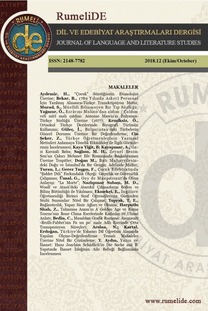“Frozen” filminin altyazı ve dublaj olarak Türkçeye çevirisinde görsel-işitsel çeviri stratejisi değerlendirmesi
Çeviri, bilgi aktarımı ve çeşitliliği için
esastır. Bu nedenle, kitap, film, dergi gibi çeşitli şeyler tercüme
edilmektedir. Animasyon filmler çocuklar için önemlidir, bu yüzden bu tür
filmlerin çevirilerinde, çevirmenlerin uygun çeviri bağlamı bulması çok
önemlidir. Bu çalışmanın amacı, “Frozen” (2013) filminin dublajlı ve altyazılı
sürümlerinde çeviri sürecinde kullanılan çeviri stratejileri yeniden tanımlamak
ve hangi stratejinin daha çok kullanıldığını anlamak ve bunu yaparken de
Bell’in eş değer teorisi çerçevesinde, eşdeğer ve eşdeğer olmayan, çevirinin ne
kadar eş değer olabileceğini anlamaktır. Filmin dublajlı ve altyazılı sürümleri
için, bu çalışma için seçilen çeviri stratejileri kullanılmıştır. Bunlar Tam
çeviri, Yakın çeviri, Adaptasyon, Değiştirme, Ekleme ve Silmedir. Çalışma
tanımlayıcı niteliksel ve niceliksel bir araştırmadır. Filmde, şarkılar hariç
tüm alt yazılar ve dublajlar analiz edilmiştir. Çalışmanın sonucu,
istatistiksel olarak filmin dublajlı ve altyazılı türlerinde stratejilerin
sıklıkları arasında anlamlı bir fark olmadığını ortaya koymuştur. Filmin
dublajlı ve altyazılı türlerinde en yaygın kullanılan strateji, Tam Çeviridir,
bu da demektir ki filmin hem dublajında hem de altyazılı türünde yüksek oranda
anlam eşitliği vardır. Diğer yandan, en
az kullanılan strateji dublajlı versiyonda “silme” ve altyazılı versiyonda
“Değiştirme” dir. Ayrıca, dublajlı versiyonda, altyazılı versiyondan farklı
olarak bazı eklemeler de vardır. Bu çalışma, basit cümle yapısı ve kelime
hazinesiyle, eşdeğer anlamın mümkün olduğunu göstermektedir.
Anahtar Kelimeler:
Animasyon filmler, çeviri stratejileri, altyazı, dublaj, eşdeğerlilik teorisi, görsel-işitsel çeviri
An assessment of audio-visual translation strategies in subtitling and dubbing of “Frozen” into Turkish
Translation is essential for information transfer
and its variety. For this reason, various things such as books, movies,
magazines have been translated. Animation movies are significant for children,
therefore, their translation have become more significant for translators to
find suitable translation context. The aim of this study is to redefine certain
translation strategies and find out which translation strategies were applied
most in the dubbed and subtitled Turkish translation of “Frozen” (2013) within the framework of Bell’s equivalent theory;
equivalent, and non- equivalent and also to understand to what extend meaning
equivalent is possible. For dubbed and subtitled versions of the movie, the
translation strategies redefined for this study have been applied. These are
Exact Translation, Close Translation, Adaptation, Replacement, Addition and
Deletion. The study is a descriptive qualitative and quantitative research. In
the movie, all subtitles and dubbings, except songs, have been analysed. The
results of the study have shown that statistically, there are no significant
differences among the frequencies of the strategies in the dubbed and subtitled
versions of the movie. The most common translation strategy in the dubbed and
subtitled version is Exact Translation, which means that there is “meaning
equivalent” in high frequencies. On the other hand, the least common strategy
in the dubbed version is “Deletion” while it is “Replacement” in the subtitled
version. Moreover, in the dubbed version, there are some additions unlike in
the subtitled version. This study shows that with the use of simple sentence
structure and vocabulary, meaning equivalent is possible.
Keywords:
Animation movies, translation strategies, subtitling, dubbing, equivalent theory, audio-visual translation,
___
- Baker, M. (2001). Routledge Encyclopedia of Translation Studies. London: Routledge. Baker, M. & Hochel, B. (1998). Dubbing. In Baker, M. (Ed.). Routledge Encyclopedia of Translation Studies (pp. 74-76). London and New York: Routledge. Bell, R. (1991). Translation and Translating Theory and Practice. London: Longman De Linde, Z., & Kay, N. (1999). Processing subtitles and film images: Hearing vs. deaf viewers. The Translator, 5 (1), 45-60. Del Vecho, P. (Producer), Lee, J. & Buck, C. (Director). (2013). Frozen. United States: Walt Disney Animation Studios. Delabastita, D. (1990). Translation and the mass media. In: S. Bassnett & A. Lefevere (Eds.), Translation, history and culture (pp. 97-105). London: Pinter. Gottlieb, H. (1992). Subtitling- a New University discipline. In: C. Dollerup, et al. (Ed.). Teaching Translation and Interpreting. (pp. 161-70). Amsterdam: John Benjamins Publishing Company. Gottlieb, Henrik. (2005). Subtitling. In: Baker, M. (ed) Routledge Encyclopedia of Translation Studies. (pp. 244-248). Shanghai: Shanghai Foreign Language Education Press. Hartmann,R.R.R. & F.C Stork.(1972). Dictionary of Language and Linguistics. London: Applied Science Publishers Ltd. Ivarsson, J. (2002). Subtitling Through the Ages. A Technical History of Subtitles in Europe. Language International, 14 (2) , 6 –10. Jakobson, R. (2000). On linguistic aspects of translation, in: Laurence Venuti (ed.), The Translation Studies Reader. London. New York: Routledge. Luyken, G. M., et al. (1991). Overcoming Language Barriers in Television: Dubbing and Subtitling for the European Audience. Manchester: European Institute for the Media. Ozcan-Dost, B. & Tarakcıoğlu, A. (2016). Turkish Culture Represented in English: Translation of Material Culture Elements in Buket Uzuner’s Novel Uzun Beyaz Bulut-Gelibolu. International Journal of Language and Literature, 4 (2), 134-142. Ozer-Erdoğan, B & Tarakcıoğlu, A. (2018). Determining Eligibility of Legal Translators in Turkish Judicial System. International Journal of Languages’ Education and Teaching, 6 (3), 40-51. Spanakaki, K. (2007). Translating Humor for Subtitling. Translation Journal: Art and Entertainment. 11 (2). Retrieved 21 March 2008, from http://translatiojournal.Net/journal/40humor.htm Taşdan, T. E. (2018). Same Question – Different Answer: Unnecessary Emphasis of Ideological and Cultural Items in The Turkish Translation of The Kite Runner. International Journal of Language Academy, 6 (2), 1-12. Tomaszkiewicz, T. (1993). Les opérations linguistiques qui sous-tendent le processus de sous-titrage des films. Poznan: Adam Mickiewicz University Press. Vinay, J. P and Darbelnet, J. (1958/2000). A Methodology for Translation. In: Venuti, Lawrence [ed.]: The Translation Studies Reader. London and New York: Routledge
- ISSN: 2148-7782
- Yayın Aralığı: Yılda 6 Sayı
- Başlangıç: 2014
- Yayıncı: Yakup YILMAZ
Sayıdaki Diğer Makaleler
Ali Şir Nevâyî’nin Vakfiye adlı eserindeki eğitsel ögelerin incelenmesi
Türkiye’nin Göç Tarihi 14. Yüzyıldan 21. Yüzyıla Türkiye’ye Göçler
Feminist edebiyat eleştirisi bağlamında Aleksandra Kollontay’ın Vasilisa Malıgina romanı
Eine morphologische Analyse der Nomina in der Parabel „Gibs auf!“ von Franz Kafka
Amasya türkülerinde şehir imajına yönelik bir değerlendirme
N. Gamze ILICAK, Ş. Güzin AYDINALP
Üstünlük kuramı bağlamında Türk ve İngiliz siyasetinde mizahın kullanımı üzerine bir karşılaştırma
Rusya’da dilbilimsel çeviri kuramı: Temel yaklaşımlar ve kavramlar
